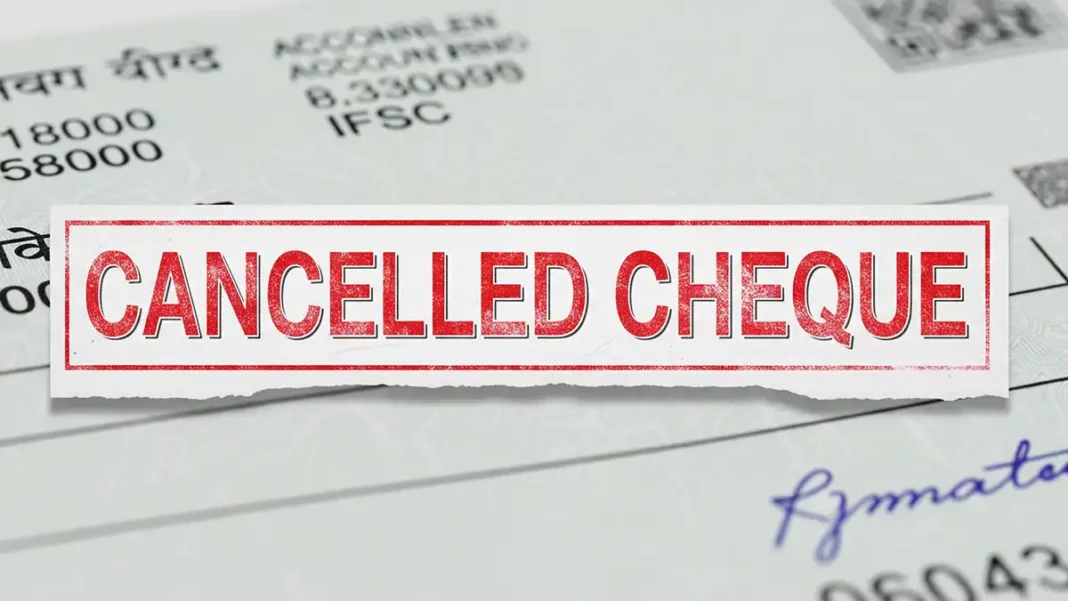The financial sector is always bringing something fresh, isn’t it? Still, some tools continue to be important, though they are not part of direct money transactions. The cancelled cheque is one such tool. Although this instrument cannot be used to withdraw funds or pay, its role in banking and verification of money is irreplaceable. In this post, we’ll discuss in detail what it is, how to properly write one, and why it’s most often demanded in all manner of monetary and legal procedures.
Why is it Important?
Whether you are opening a loan account, taking a mutual fund SIP, or doing Know Your Customer (KYC), this is an essential part of validating your bank account information. Whether you’re a new hire, a freelancer, or an applicant for a loan, it’s important to know how to work with and properly write one.
What is a Cancelled Cheque?
It is an ordinary cheque from your cheque book, which has been crossed with the word CANCELLED written across it. Once cancelled, this cheque cannot be used for the withdrawal of money or for making any financial transaction.
Vital Bank Account Details on a Cheque
- Your name (if printed)
- Bank name and branch
- Account number
- IFSC code
- MICR code
Such information is usually needed for formal reasons; hence, it is a widely sought document for financial confirmation and registration.
Step-by-Step: How to Make a Cancelled Cheque
This is a very simple thing to write, but accuracy must be ensured so as not to be misused. So, this is how to cancel a cheque. Below is a cancelled cheque example to help you get it right:
1. Choose a Fresh Cheque Leaf
Select an unused cheque from your cheque book. It does not have to be the front leaf, but must not have been previously filled in or signed.
2. Draw Two Parallel Lines
Using a permanent ink pen, draw two tidy horizontal lines right across the cheque from one edge to the other. This shows that the cheque is not valid for money transactions.
3. Write “CANCELLED” Across the Middle
Between the two lines, legibly print the word CANCELLED in capital letters. It must be bold as well as big enough to cover the important part of the cheque but should not hide crucial information such as your name, account number, and IFSC code.
4. Optional: Safety Notes
As a further precaution, you can also put “For KYC Only” or “For ECS Setup” on the cheque, depending on the nature. This serves to restrict the cheque even more.
5. Signature: Optional but Recommended
Most banks do not ask for your signature on a cheque, but sometimes your signature is requested to ensure authenticity. In case of doubt, put your signature in the space provided on the cheque.
How to Give a Cancelled Cheque?
You might wonder, what is a cancelled cheque? So, if such a cheque can’t be used for any transactions, why is it so widely requested? The answer lies in the data it provides. The cheque gives third parties verified access to your bank account information without risking unauthorized withdrawals.
Let’s explore common scenarios where such a cheque is essential.
1. ECS Mandates and Auto-Debit Services
Whether it is for EMI, mutual fund SIP, or insurance premium, most regular payments need ECS (Electronic Clearing Service). It comes in handy to authenticate the account number and IFSC code for such automatic payments.
2. Salary Credit
When you start working for a new organization, HR will ask you to provide a cheque to facilitate salary credits to your account. It helps your salary get credited to the right bank account at the right time without any errors.
3. Opening a New Account or Demat Account
Banks, broking firms, and other financial institutions usually request a cheque to verify your account. It’s a part of their internal validation process.
4. Loan Applications
While taking a personal loan, home loan, or car loan, banks might ask for a cheque to ensure that the EMI deductions are made from the right account.
5. KYC Compliance
KYC or Know Your Customer regulations mandate identification and address proof. Cancellation of a cheque is among the most convenient methods for obtaining account genuineness in KYC documents.
6. Tax Refund Processing
Should you be due for a refund upon submission of your Income Tax Return (ITR), you might be requested to furnish a canceled cheque. This is to ensure that your refund is credited to your right bank account through NEFT.
7. Refunds and Insurance Claims
Most insurance firms request a canceled cheque when dealing with maturity values, closure of policies, or refunds. It acts as proof of a bank account to release funds securely.
8. Freelance Work and Vendor Payments
As a business vendor or freelancer, clients request a cheque to arrange direct bank transfers. It makes payment easier and eliminates human errors in bank details.
Things to Remember While Writing
Even though the procedure is easy, remember the following vital precautions at all times:
Never Leave Cheque Fields Blank Except as Required
Don’t leave blank the date, payee, or amount fields. They need to be left blank, and the word CANCELLED only need to be clearly written across the cheque.
Use Permanent Ink
Avoid erasable pens or pencils. Utilize a black or blue ball pen or gel pen containing indelible ink to avoid tampering.
Don’t Cover Key Details
See to it that the word CANCELLED does not obscure vital information such as account number, IFSC, or MICR code.
Don’t Give a Signed Blank Cheque Unnecessarily
Although some agencies may ask for a signed cheque, only provide it to trusted parties. In a cancelled cheque signature is required, but not unavoidable. Fraudsters can misuse signed cheques if precautions aren’t taken.
When Not to Use a Cancelled Cheque
A cheque is not required in all financial transactions. As digital verification processes like UPI and net banking gain wider acceptance, some services now accept screenshots of account pages, passbook copies, or statements as substitutes.
Nevertheless, most institutions still trust the hard copy security of a cancel cheque when it comes to verifying accounts, particularly when handling significant sums of money or sensitive records.
Prevention Is Better Than Cure When It Comes to Finance
Always have a few blank cheque leaves kept in safe custody, and never part with a cancelled cheque without knowing the reason you’re being asked for it. It’s an innocent-looking slip, but it contains the key to your bank account. Treat it with the same respect you would your debit card or PIN. Knowing how to write and use a canceled cheque properly gives you the empowerment to undertake financial transactions more boldly, securely, and economically.
Final Thoughts
In this age of technology, the modest cancelled cheque leaf might look out of place, but it is a reliable and uncomplicated document to check bank details. It’s employed in everything from salary arrangement and ECS registration to KYC and tax return. It’s simple to write one, but be careful about what and where you use it.
Also Read:
Check Your Eligibility to Apply for a Bajaj Finserv EMI Network Card in a Few Easy Steps
David William comes from an Engineering background, with a specialization in Information Technology. He has a keen interest and expertise in Web Development, Data Analytics, and Research. He trusts in the process of growth through knowledge and hard work.


